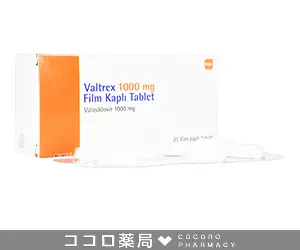絶対常備してる。ヘルペスができやすいし、効き目も早いからお気に入り。これがないと本当に困る。

左記クレジットカード、銀行振込、コンビニ決済に対応



更新日:2025/4/25

| 個数 | 販売価格(1錠あたり) | 販売価格(箱) | ポイント | 購入 |
|---|---|---|---|---|
| 21錠 | 417円 | 8,760円 | 262pt | |
| 42錠 | 299円 | 12,560円 | 376pt | 売り切れ |
| 84錠 | 226円 | 19,060円 | 571pt | 売り切れ |






①1万円以上で送料無料
1回の注文で10,000円以上だった場合、1,000円の送料が無料となります。
まとめ買いをすると1商品あたりのコストパフォーマンスが高くなるためおすすめです。
②プライバシー守る安心梱包
外箱に当サイト名や商品名が記載されることはないため、ご家族や配達員など第三者に内容を知られることは御座いません。

③100%メーカー正規品取り扱い
当サイトの商品は100%メーカー正規品となっており、第三者機関による鑑定も行っております。
商品の破損などがあった場合は再配送などにて対応させて頂きますので、ご連絡頂ければ幸いです。

④いつでも購入可能 処方箋不要
サイト上では24時間いつでもご注文を受けております。
また、お電話によるご注文も受け付けておりますのでネットが苦手な方はお気軽にどうぞ。

⑤商品到着100%
商品発送後はお荷物の追跡状況が分かる追跡番号をご案内させて頂きます。
郵便局には保管期限がありますのでご注意ください。
・自宅配達で不在だった場合の保管期限・・・16日間前後
・郵便局留めとした場合の保管期限・・・7~30日間

⑥コンビニ決済利用可能
ご近所のコンビニにていつでもお支払可能です。
セブンイレブンに限り店舗での機械操作を必要とせず、手続き完了後に表示されるバーコードや払込票番号をレジに提示することでお支払い頂けます。

バルトレックス 1000mg x 21錠
8,760円
ポイント:262pt
10,000円以上購入で送料無料
在庫あり

絶対常備してる。ヘルペスができやすいし、効き目も早いからお気に入り。これがないと本当に困る。
届いたときの状態があまり良くなくて少し残念でした…。
口の周りにできる単純疱疹や性器ヘルペスの再発予防、それに造血幹細胞移植を受けた人で起きるヘルペスウイルス感染症の発症予防にも使われる薬です。
バルトレックスは、性器ヘルペスの治療中にパートナーへ感染を広げるリスクも減らせることが示されています。ウイルス量を減らす働きによって、感染予防にもつながると考えられています。
帯状疱疹のウイルス増殖を抑えることで皮膚の発疹だけでなく、痛みの軽減にも役立ちます。特に治療を早く始めることで後々まで残る強い痛みを防ぐ効果が期待できます。
大人や体重が重い子どもの水ぼうそうに対しても効果が確認されています。水ぼうそうの発疹が広がるのを抑え、回復を早めるために使われることがあります。
治療する病気によって飲み方が違います。例えば帯状疱疹では1日3回、単純疱疹では1日2回飲むことが基本です。症状や体の状態によって変わることがあるので、必ず先生の指示通りに飲みましょう。
バルトレックスは食事の前でも後でも、どちらでも飲むことができます。お腹にやさしい飲み方をしたい人は、食後に飲むと安心です。
バルトレックスを飲み忘れたときは、気づいたときに1回分を飲みましょう。ただし、次に飲む時間が近い場合は、忘れた分は飛ばして、次からいつも通り飲んでください。2回分をまとめて飲まないようにしましょう。
バルトレックスは、症状がよくなったと感じても、自己判断で飲むのをやめてはいけません。治療をきちんと終えないと、ウイルスがまた元気になってしまうことがあるので、最後まで飲み続けましょう。
バルトレックスを飲むと、まれに頭が痛くなったり、吐き気がしたり、お腹がゆるくなることがあります。たいていは軽い症状ですが、体調がおかしいと感じたらすぐに病院を受診しましょう。
腎臓の働きが弱い人や透析中の人では、薬が体にたまりやすくなることがあります。そのため、医師が飲む量を調整してくれるので、指示通りにきちんと服用しましょう。
バルトレックスは、腎臓に負担をかける薬(たとえば一部の抗生物質)と一緒に飲むと副作用が出やすくなることがあります。ほかに飲んでいる薬があるときは、必ず先生に伝えてくださいね。
バルトレックスにアレルギーがある人は絶対に飲んではいけません。以前にアシクロビルやバルトレックスを飲んで発疹や息苦しさが出たことがある人は、必ず事前に先生に伝えましょう。
| 1日の服用回数 | 2回 |
|---|---|
| 1回の服用量 | 500~1000mg |
| 服用のタイミング | 朝晩 |
| 服用期間 | 12時間 |
| 1日の服用回数 | 1回 |
|---|---|
| 1回の服用量 | 1000mg |
| 服用のタイミング | 朝昼晩 |
| 服用期間 | 6時間 |
| 1日の服用回数 | 1回 |
|---|---|
| 1回の服用量 | 1000mg |
| 服用のタイミング | 朝昼晩 |
| 服用期間 | 6時間 |
| 1日の服用回数 | 1~2回 |
|---|---|
| 1回の服用量 | 500mg |
| 服用のタイミング | 指定なし |
| 服用期間 | 24時間 |
| 商品名 | バルトバル | バルシビル | ゾビラックス | バルクロビル | アシビル-400DT | アシビルクリーム |
|---|---|---|---|---|---|---|
| 商品画像 |  |  |  |  |  |  |
| 特徴1 | ・ヘルペスウイルスの増殖を抑制 | ・1型2型どちらにも有効なヘルペス治療薬 | ・有効成分の含有量が3種類 | ・体内で変換されて抗ウイルス効果を発揮 | ・国内の抗ウイルス薬と同成分を配合 | ・ヘルペスの再発予防にも使える |
| 特徴2 | ・発症初期に服用するとより効果的 | ・外用薬タイプのアシビルクリームもある | ・外用タイプのヘルペス治療薬アシビルクリームもある | ・吸収効率がいい第2世代の抗ウイルス薬 | ・発症初期の使用でより効果的に症状を改善できる | ・内服薬よりも少ない副作用で治療が行える |
| 内容量 | 500mg12錠x1箱 | 500mgx15錠 | 200mgx25錠 | 500mgx20錠 | 400mg500錠x1箱 | 5mgx1本 |
| 価格 | 6,460円 | 4,760円 | 4,060円 | 5,960円 | 19,860円 | 650円 |
| 0.5%以上 | 0.5%未満 | 頻度不明 | |
| 過敏症 | 発疹、蕁麻疹、そう痒、光線過敏症 | ||
| 肝臓 | 肝機能検査値の上昇 | ||
| 消化器 | 腹痛、下痢、腹部不快感、嘔気 | 嘔吐 | |
| 精神神経系 | 頭痛 | めまい | 意識低下 |
| 腎臓・泌尿器 | 腎障害 | 排尿困難 | 尿閉 |
本製品は海外製のため、期限表記が日本と異なる場合がございます。
パッケージ裏面や側面、シートなどに以下のような表記がされています。
| EXP | 使用期限 例:EXP 12/2025→2025年12月まで使用可 |
|---|---|
| MFG または MFD | 製造日 例:MFG 03/2023 |
| BEST BEFORE | 品質が最も安定している目安日 |


※国や製品により日付の並び(例:月/年、日/月/年)が異なる場合がありますのでご注意ください
EXP(Expiry Date) の表記がなく、MFG または MFDしか記載がないケースがあります。
この場合は MFG(MFD) から2~3年が使用期限の目安です。
※「LOT」や「BATCH」の表記は製造番号であり期限ではありません。

パッケージ例となります。
商品やご注文単位によってはシート単位でのお届けとなる場合が御座います。
外箱に当サイト名や商品名が記載されることはないため、ご家族や配達員など第三者に内容を知られることは御座いません。
絶対常備してる。ヘルペスができやすいし、効き目も早いからお気に入り。これがないと本当に困る。
性器にヘルペスが、、、病院で見せるのが嫌なのでバルトレックスで治療中。副作用は特に気にならないですね。このまま症状が落ち着くまで飲み続けます。
性器ヘルペス再発予防のために服用中。通院しなくてもいいから助かる。忙しいと病院に行く時間さえも作れないから、これからも世話になるわ。
副作用はほんの少し感じたけど、しっかりとヘルペスは治りましたよ!通販サイトみたいに薬が買えちゃうから便利ですね。他の薬もここで買おうかな。
疲れが溜まると出てくる憎いヤツ。病院に行けないと治りが遅くなるから、バルトレックスで対応してる。数日で治ってくれて、副作用もないから安心。3回くらいはリピートしてるかな。

商品口コミの投稿は会員のみ行えるようになっております。
お手数ですが会員ログインの上でご投稿頂きますようお願いいたします。
口コミをご投稿頂いたお客様にはポイントをプレゼントさせて頂いております。
文章のみであれば100ポイント、文章+写真付きのものは300ポイントをプレゼントさせて頂きます。
規約や詳細などはこちらをご確認くださいませ。